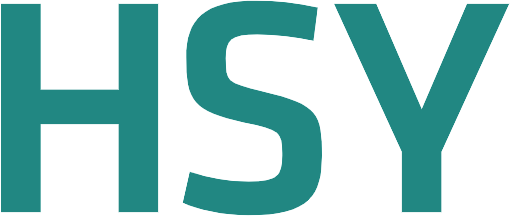Nature-based solutions for stormwater management in the Helsinki Metropolitan Area, Finland – Prerequisites and good practices
Information
Helsinki Region Environmental Services Authority
30.12.2021
Nature-based solutions for stormwater management in the Helsinki Metropolitan Area, Finland – Prerequisites and good practices
Helsinki Region Environmental Services Authority
P.O. BOX 100
00066 HSY
Tel +358 9 1561 2110
Faksi 09 1561 2011
www.hsy.fi
Author: Niina Kautto
Further information:
Maaria Parry, maaria.parry@hsy.fi
Cover photo: HSY/ Mikko Käkelä
Discussion
This Chapter discusses the interview findings in light of the research questions in Section 2.1. and the reviewed literature. Also, perspectives from Chapters 6-9 are brought to the discussion especially in terms of types of solutions, monitoring & maintenance as well as governance.
As presented in Chapter 3, the definitions of “green” and “nature-based” solutions for stormwater management have many similarities. Also terms “ecological” and “natural” have been used in the same context. Interviews of city informants were used as an opportunity to clarify which terms are currently utilised in the field.
When asked about the definition, or the way city representatives speak about nature-based solutions in the stormwater management context, three out of four cities made a distinction between a nature-based (in Finnish “luontopohjainen”) and natural (in Finnish “luonnonmukainen”) solution. Informant from Helsinki expressed favouring the term “natural” because the nature-based solutions can be understood to be strongly constructed but imitating nature, i.e. “built nature”. The most effective stormwater management was argued to usually be existing nature that is not touched. However, that was considered rare and challenging thing to do in built environments. Vantaa’s informant told that her colleague suggested one should talk about “sustainable” stormwater management because none of the solutions may be fully natural.
Informant from Espoo likened the two terms similar; however while nature-based can mean being inspired by nature, it can also mean implementation that is artificial (Helsinki representative called it using partly technical solutions). Natural stormwater management was described to be about utilising the existing environment and implementing the solutions so that they support nature’s structures and understanding that it has also other values beyond stormwater management such as increasing biodiversity. The management solution is not only a technical implementation but also about looking at the benefits of nature more holistically.
These responses reflect the fact the use of the term “natural stormwater management” has been in use longer than that of nature-based solutions, and it has become established in the vocabulary, among other things, in the Finnish stormwater related legislation, guiding documents and city-level programs. The idea of natural stormwater management is included in related principles and strategies and has largely become business-as-usual thinking.
Having said that, the definition of nature-based solutions appears to be more clearly defined especially in terms of responding to several societal challenges, resulting in multiple co-benefits as well as being more efficient and cost-effective than traditional approaches (see Section 3.3.). Therefore, it seems that natural stormwater management has still some way to go to be strictly considered as nature-based solutions. For the purposes of this study, however, green or natural stormwater management is considered to be included in nature-based solutions for stormwater management.
Stormwater management solutions favoured by the cities
Reflecting on the previous question, the stormwater management solutions the HMA cities implement are often hybrid solutions, that is, including both green and grey infrastructure. This is likely due to dense building in cities. The lack of space, that nature-based solutions often require, leads at least partly to underground structures, such as cassettes and pipes, with aboveground infiltration and detention structures. Lack of space was brought up by informants from all HMA cities; it was argued as a limiting factor for NBS also by EEA (2021) and Oral et al. (2020).
In Helsinki, detention and sedimentation basins are reported as the most common structures. However, there are also other solutions that have been implemented (or in development, such as those in the Kuninkaantammi ecological district). While Helsinki is the only city exhibiting the historic built-up land use category, no nature-based solutions were found to have been implemented in the historic city centre and the stormwater goes straight to the combined sewerage. This is because Helsinki city centre includes a lot of underground infrastructure that prevents basic types of stormwater infiltration structures. Temporary solutions, such as greenery in parking spaces, could be implemented but not because of stormwater management but to enhance the area’s attractiveness.
In Vantaa, it was emphasised by one of the informants, that the priority order dictates that stormwater is treated and utilised at the place of origin, and new town plans also require that (the same applies in Helsinki). Therefore, detention solutions in yards have become common though solutions vary quite a lot. In fact, according to another city informant, there have been built (or designed) about 50 stormwater management structures in the last 20 years, mainly aboveground and natural structures such as detention basins, wetlands and biofiltration areas.
In Espoo, wetlands and stormwater basins are frequently built and utilised, and thus clearly favoured. Many different types of stormwater management solutions have been utilised depending on the available space, limitations of the landscape and the objectives of the management. The choice of solution is largely based on the management need, that is, whether quantity or quality management is implemented, both or if groundwater is to be considered. Also very important criteria are how these solutions are maintained and what the recreational, attractiveness and nature values are. Wetlands are intended to look like natural wetlands, but they are constructed (or “artificially implemented”) and need to include maintenance routes.
In Kauniainen, open ditches and depressions are mainly favoured in treating (evaporating and detaining) stormwaters. This is because the city is hilly and rocky with narrow street networks. Also, the small city is surrounded everywhere by the City of Espoo and the stormwaters are discharged into Espoo. Hence, it is attempted to reduce the point load to Espoo by retaining and detaining stormwaters as much as possible.
These findings reflect what was presented in the literature on the frequent combination of green and grey solutions. As Seddon et al. (2021) put forth, there is an opportunity to discover synergies among different solutions instead of considering nature-based solutions as an alternative to engineered solutions. When comparing to the study of Ruangpan et al. (2019) on the most common NBS measures in urban areas, the Helsinki Metropolitan Area solutions seem to include more wetlands and detention basins. It might be either that structures like permeable pavements, green roofs and trees are more frequently utilised in private areas (such as in Helsinki where the Green Factor is used in private plots); or the HMA still has relatively more space and permeable areas compared to other urban areas in the world. As Ruangpan et al. (2019) indicates, combining nature-based measures can lead to greater runoff volume and peak flow reduction.
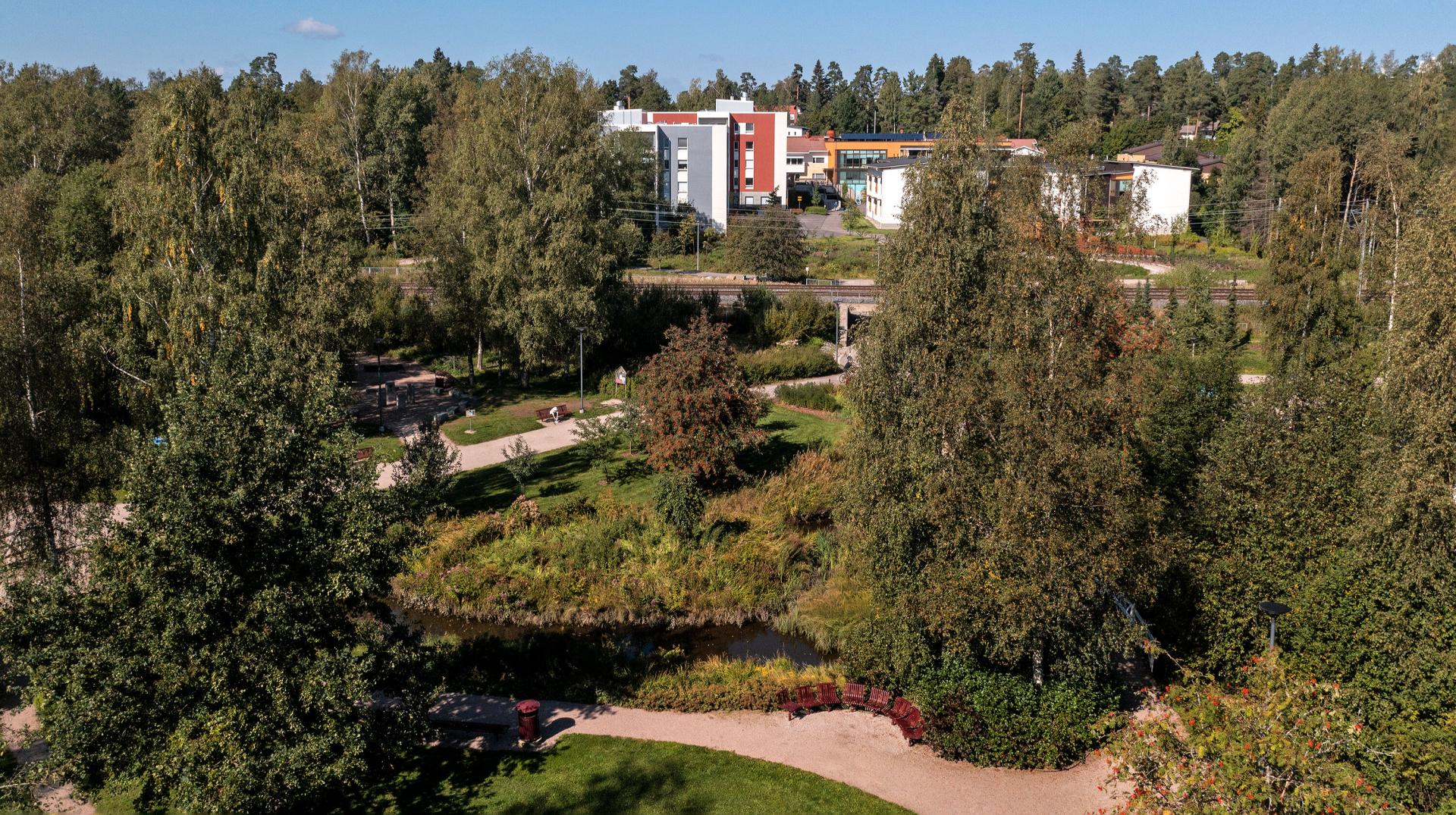
Co-benefits of stormwater management solutions
In common areas in Helsinki, adding green is not done only on the basis of stormwater detention but also to increase the area’s attractiveness (e.g. for instance in parks the water elements are part of the park’s or area’s structure). However, it is also recognised that, in the event of increased frequency of heavy rains, the only way to increase detention, and decrease the water flow to sewer system pipes, is to apply green solutions.
In Vantaa, the design of nature-based solutions is considered in a multifaceted way; landscape architects and water services management engineers jointly plan these solutions to manage the stormwater quantity and quality, related vegetation and through that biodiversity opportunities and aesthetics.
In Kauniainen, it is admitted that not all natural stormwater management benefits have necessarily been recognised, and that there is no working group to determine these values. However, they are increasingly recognised along with the increasing general awareness. The benefits have become from the architectural design to land use and planning.
In Espoo, biodiversity is said to be well considered in the design of stormwater management solutions, even though it would be good to think what it actually means. For instance, when a stormwater wetland is built, generally a flood plain meadow mix is added (or other similar beach meadow vegetation mix) and just left to develop. The maintenance is maintaining the open water surface, ensuring that the in- and outlets stay open and removing the sediment gathered on the bottom. In the future, it would be good to go further than this, for instance, to think about if there are trees around the wetland, and what types of edges the banks are; as well as what type of maintenance it is, what is removed and what is left, and what types of species it might attract. And, if there are already some species, it is useful to consider how it is connected to other same types of sites or solutions. That is, while the quantity and quality of stormwater management is the priority of these wetlands, one has to think about how the biodiversity is actually realised. That has to be considered both in the design and maintenance phase. There is also a need for monitoring and knowledge on user experiences, argued one of the Espoo informants.
As was presented in Section 3.3., nature-based solutions provide a number of other benefits in addition to managing the stormwater quantity and quality. Helsinki’s Helene Schjerfbeck’s park and Vantaa’s Koisotie road snow reception area serve as good examples of sites where recreational, landscape and biodiversity enhancing benefits are combined with management of stormwater quantity and quality. It is noteworthy, however, that the benefits mentioned by the cities' staff were rather limited (e.g. biodiversity, attractiveness, recreation) compared to the larger set of benefits presented in different studies. This suggests that there may be difficulties in assessing such benefits, or that the cities' staff are not aware of them.
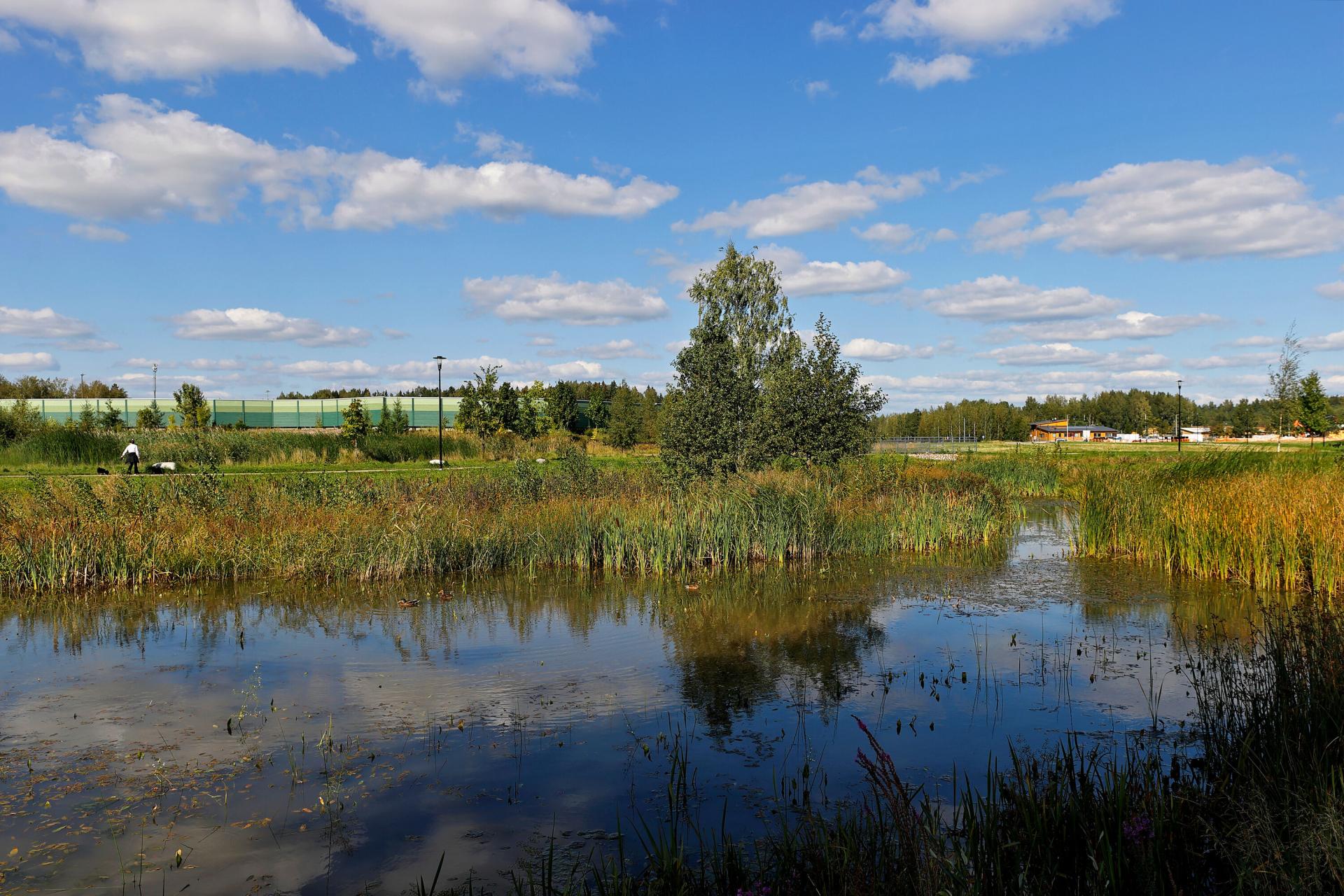
Planned stormwater management solutions
The informants also spoke about what is planned at the moment in terms of stormwater management in developing city areas. In Helsinki, Hermanninranta beach was mentioned as an interesting example where the construction is intended to conserve nature. The planning and town plans are now in development. The common areas will include a lot of green infrastructure and stormwater management solutions.
In Vantaa, Aviapolis (a major area in the center of Vantaa with a population of about 20,000, and home to the international Helsinki-Vantaa Airport) is intended to exhibit sustainable city development in which former employment areas are transformed into residential areas without destroying existing nature. Nature-based solutions are very important when the area’s purpose of use is changed. For example, large stormwater pools are planned for the area near the centre; also the new town plans of the area define the inclusion of biofiltration areas, a lot of vegetation and such. Also, the lack of space was considered a central issue when the city’s growth is based on densification. Only the areas that were reserved for building in forests and on fields in the current master plan can include “new openings”. Nevertheless, when the city is renewing with dismantling renovation for instance in the Veromies area in Aviapolis (that has massive logistics storage halls and asphalted parking areas), nature can and will be brought in with nature-based solutions from where it has earlier been fully removed. Kivistö is another developing district where several nature-based solutions are planned to be applied, and roof spaces are to be effectively taken into use (See Chapter 8.).
In Espoo, spaces for stormwater management solutions are attempted to be found from green areas or such in the planning phase. Nevertheless, problematic are especially those old areas where there is no space for new solutions, and there is a need to seek underground solutions. It is rarer that impermeable surfaces have been removed. In this instance, it was mentioned that underground solutions, such as the Otsolahti biofiltration site connected to the main stormwater line, have been tested and noticed that such underground structures are very challenging to maintain, and to monitor how well they work. It is considered safer to implement aboveground structures even though the area has a lot of impervious surface. Also when going underground, one loses the other benefits, such as recreational values and increasing biodiversity.
In south-east Kauniainen, at Bensowinkuja street, the city has prepared for increased runoff along with the anticipated building of the nearby area by reserving a space in which a bigger detention basin could be built to avoid flooding. The site at the moment has a natural stormwater management solution, a ditch with erosion mats and planted perennial plants withstanding moisture.
The reviewed literature mentions removing impermeable surfaces especially in the larger-scale content of implementing NBS. In this study, this option concerns also smaller-scale solutions. New areas and old areas with change of purpose offer opportunities for the nature-based solutions to be built. Also, while there is a limited space for nature-based solutions on the ground level, roof surfaces can offer more opportunities to implement NBS.
Monitoring of function and maintenance
Helsinki
According to a Helsinki informant, the function of stormwater management sites has been often monitored only during the duration of the externally funded projects – or if it has happened after the project, it has been carried out irregularly. Monitoring is considered rather costly and demanding to realise and, funds have not necessarily been budgeted to it. Nevertheless, as mentioned in Section 6.2., the City of Helsinki is currently examining the water quality improvement performance of some of its nature-based stormwater management sites.
Also, the selected sites in Helsinki – Kuninkaantammi ecological district’s and Maunulanpuisto park’s solutions – the performance were found to be monitored at least to a certain extent stormwater quality wise (while Kuninkaantammi is a newer site and there is not much monitoring data available, Maunulanpuisto park biofiltration area has been monitored also after the project, within which the solution was realised, has ended). While the city does not have register or maintenance card file of stormwater management sites, it is currently in the process of investigating its nature-based stormwater management structures. This was motivated by the requirement to consider stormwater management structures in the city plan; also putting the master plan in practice has made the issue timely, and the requirement to use the Green Factor leads to the implementation of natural stormwater management solutions in plots. Moreover, this process has been boosted by the HUTI project (see Section 4.1.).
Vantaa
Vantaa has developed a maintenance register or card file for stormwater management sites that is intended to support monitoring of the city’s stormwater management sites. Maintenance cards include a timetable and task list of checks; also timing of long-term maintenance is defined. The city has also estimated the costs associated with stormwater management sites’ maintenance in 2021-2026. Both informants expressed that there is usually lack of resources for building, and especially maintenance, of stormwater management systems. The maintenance register however can partly tackle this issue.
Related to the monitoring of co-benefits, such as nature’s biodiversity, one of the informants considered that monitoring of vegetation development would be interesting, though thought that it is not probably done, and no resources have been reserved for that.
It was brought up that the pilot sites have rarely long-term monitoring. With regard to the city’s selected solution sites, also considered pilots, (Koisotie road's snow reception area and Meiramitie road bioswale), both are to be visually monitored yearly. However, there is little or sporadic monitoring data available. The Meiramitie road site was deemed having issues e.g. with levelling and stormwater flowing to an unwanted direction (see Section 8.2., Lehikoinen 2015), and these can act as learnings for similar biofiltration sites in the future.
Espoo
Also in Espoo, there are maintenance cards for stormwater management sites that include the objectives for maintenance, and tasks to be performed during checks. However, it seems that they have not yet actively been updated since they were developed in 2019 (see Chapter 7).
On of the informants considered the exclusion of monitoring a large shortcoming in implementing stormwater management structures, especially the nature-based ones. In other words, many stormwater management sites are lacking the monitoring information, and only a few have included the follow-up after they have been built. At the moment, the maintenance team goes to check the sites regularly just to remove unwanted or excessive vegetation. There would not only be a need for data on how the wetland works (requiring information on flow changes as well as taking water samples and laboratory analysis) but also for how often it needs maintenance. Also of interest would be to find out whether different types of structures have differing maintenance needs, or whether the ‘nature benefit’ is maximised and if that significantly increases the maintenance need. This information would help determine whether wetlands (or other stormwater management structures) should be realised in locations with existing nature, such as park land or green areas, or whether they should be prioritised in areas where the impermeable surfaces need to be removed.
Moreover, monitoring was considered a funding issue rather than a staff number or know-how issue. The process of developing a nature-based stormwater management solution was called for to include the maintenance and other essential personnel at an early stage. Otherwise, at later stages of the process one might too late notice that the solution is difficult to maintain.
The informant also proposed a common project to be implemented in the Helsinki Metropolitan Area in which different types of, as well as older and newer stormwater management structures would be monitored and collected user experiences. This could partly overcome the funding issue for monitoring and help generate information on the benefits of stormwater management structures and their maintenance.
With regard to the selected sites in Espoo, the performance of the solutions has been determined only visually in Huhuilijanpuisto park wetland, whereas the Merituulentie road bioswales have been monitored at least once for stormwater quantity and quality. As presented in Section 7.1., in Huhuilijanpuisto park the maintenance checks detected a need for repair measures, and the informant shared a learning that stormwater management sites do not often form a functioning whole instantly.
Kauniainen
In Kauniainen, the maintenance need of the current few sites is reported to be low, or not needed, as the water amounts have been low and there are generally no structures that would require maintenance (such as wetlands or detention basins with no infiltration ability). In fact, the maintenance is mainly keeping the conveying stormwater structures open so that the water can flow forward. In addition, the sites have been selected that type of vegetation that does not hinder the functioning of the site. When it comes to the quality monitoring of stormwaters (e.g. for hazardous substances or heavy metals etc.), that has never been done in the city. The examination of the performance is largely that the flood risks are minimised. One informant had suggested such measurements earlier, but the equipment would have been too costly for the city to fund it.
To summarise, monitoring of nature-based stormwater management sites is generally considered insufficient or lacking. This is the case especially in terms of quality management that requires taking water samples and laboratory analysis. The interviews confirm that the focus has mostly been on managing stormwater quantity but recently also quality has become of interest. Visual checks and regular maintenance are said to be performed in three out of four cities, but the quality monitoring is rather rare (or limited to projects or student thesis works) due to a lack of funding. However, maintenance card file in Vantaa and Espoo help keep track of maintenance needs and partly help allocate limited funds. Other benefits like biodiversity are not clearly defined or monitored. Hence, in many cases, it is not possible to determine how successful these nature-based structures are as there is often no monitoring data available (of the stormwater quality or other benefits such as biodiversity maintenance). While not specifically investigated in the interviews, impact evaluation was not brought up in any interview in connection to the monitoring of solutions.
As emphasised by the European Commission (2021a), monitoring and impact evaluation of nature-based solutions is vital to measure the success of individual nature-based projects, and to inform further actions as well as to support evidence-based land use planning and policy-making. Moreover, those are essential to fully understand the benefits and trade-offs of such solutions (European Commission 2021a).
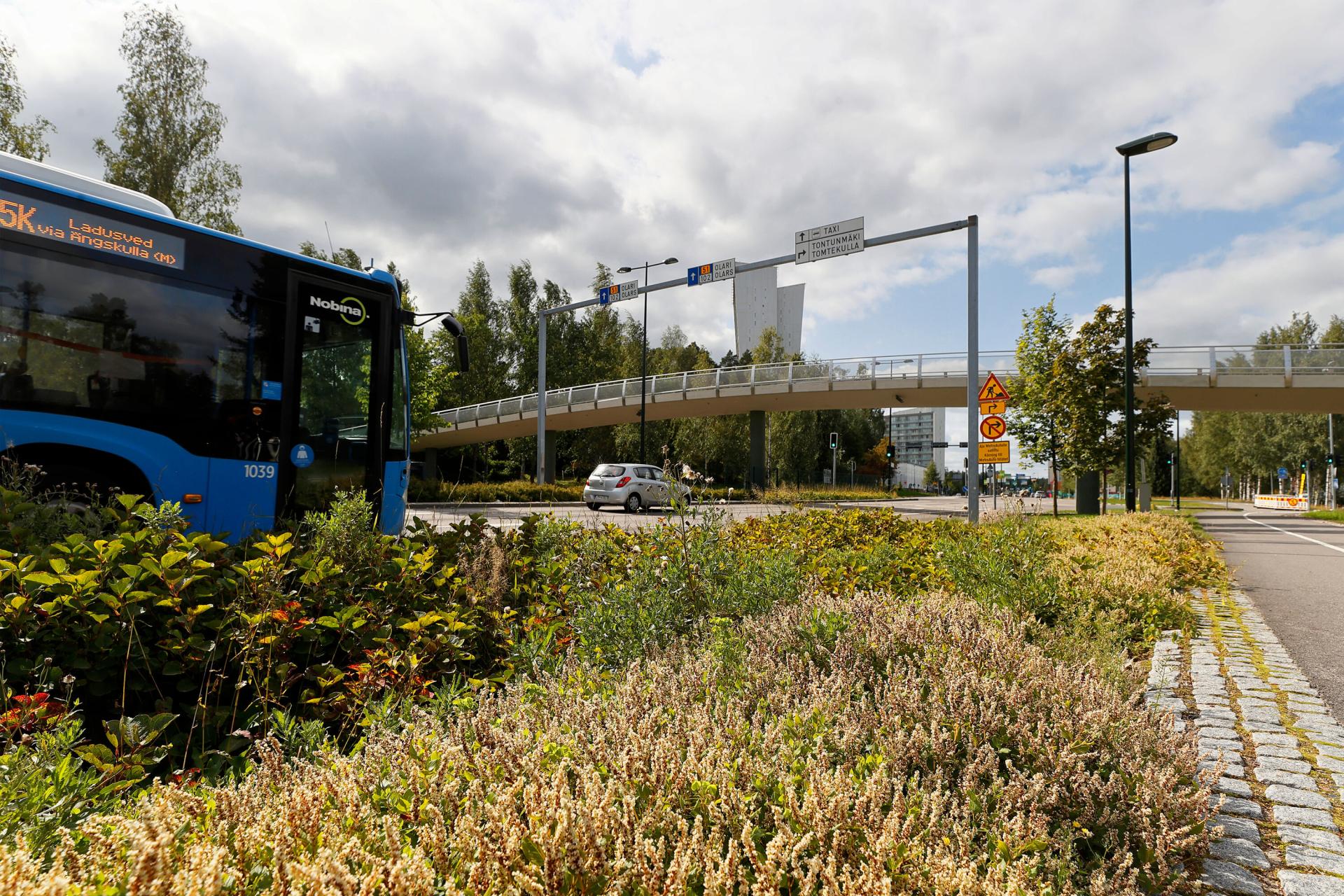
Governance structures and practices
Helsinki
As mentioned in Chapter 6, City of Helsinki has a stormwater group consisting of representatives of different services of the Urban Environment Division. According to one informant, the group is performing its task alongside with other work, is decentralised to different services in the Urban Environment Division, and does not have authority e.g. on allocating resources. In addition, while technical planning of stormwater management is involved with land use planning – of which natural/ nature-based solutions are part – nature-based solutions or integrated water management do not have its own expert in the planning process. Hence, it was argued that the city would benefit from a dedicated stormwater coordinator or responsible person. In any case, no group was seen to be able to take responsibility of the whole city-level stormwater management.
It should be noted that the stormwater group has recently gotten a new chair, and there have been discussions in the group that climate change adaptation acts as an umbrella issue to stormwater management issues. The ownership of stormwater issues was to be discussed as of summer 2021.
An informant also put forth that the dialogue should be very tight or seamless when the methods, and management of living organisms like trees and other vegetation as well as soil, are so different from traditional grey structures and “basic pipe job”. It requires different types of action, know-how and cooperation practices. The city’s Storm Water Management Program is an attempt to the direction of bringing all important actors around the same table (or program), such as the experts or their representatives dealing with the planning and management of stormwaters as well as maintenance. Unlike pipes, the natural or nature-based structures need continuous upkeep that takes time, are more diverse and involve multi-actor work. No one yet fully knows what works where and how – and it is not as simple as it may look like, the informant stated.
Vantaa
In Vantaa, city’s stormwater working group has convened since the establishment of the stormwater management program (2009). That is the essential governance structure with all the relevant internal people and includes also external stakeholders. The stormwater management program from 2009 is still considered to be relevant as it has the main principles and was followed by the stormwater management operation model (2014). Also, there is the established practice built in the town planning to examine how the stormwater management system is going to work in a specific area. Streets and parks in public areas include stormwater detention areas. In addition, the “Green Efficiency” method is defined in all town planning, and can contribute e.g. to adding vegetated (green) roofs in living quarters.
One study investigating the function of the Meiramitie road biofiltration site emphasised as the most important learning changing of meeting practices to make sure a continuing dialogue with all affected parties throughout the process of designing, building, monitoring and maintenance. It was also considered essential to document both successes and challenges to be able to learn from them. (Lehikoinen 2015).
Espoo
Stormwater management solutions are generally implemented as part of the park design or town planning processes, so the locations of stormwater management structures are defined in the town or park plans. These processes actively involve the environmental protection service area, and include many types of experts from urban engineering, maintenance staff, recreation people and engineers to discuss how to place playgrounds and how to take stormwater utilisation into account in them. The cooperation was considered to work well, and everyone is really interested in advancing stormwater know-how.
The city has its own stormwater working group, which convenes several times a year. It discusses stormwater management solutions and development issues in a diverse way (such as what types of structures are safe and enable passing of aquatic animals). The group includes broadly different city departments and tries to reconcile various viewpoints in the best way, and then instruct the service providers about the best solutions.
There is also the climate change adaptation working group that discusses these matters to some extent. Moreover, a so-called power team has been formed, consisting of five persons (two from urban engineering, two from building inspection and one person from urban environment sector) that solves problems related to stormwater damages. This team is assisted by law personnel. The team has made an instruction on how to deal with situations in which, for instance, an open ditch starts to flood, and it causes damages to the buildings. Stormwater related issues are often so diverse that one actor is not enough. They have noticed in the city that all three departments need a common discussion so that they know how to act.
Also, one informant calls for courage to test and try different types of solutions and finding an optimum for every site, instead of a “assembly-line implementation”, even if funds are tight. The city staff is open to hear about new ideas and innovations, and they add inspiration to these projects.
Kauniainen
As a small organisation, Kauniainen does not have a dedicated stormwater management program or similar. The small size was regarded a strength in a sense that a certain issue can be activated, and relevant people can be gotten on board, rather quickly. Also, the information flows quicker to the right people compared to a bigger organisation. There is the community office’s project working group that can discuss these matters. However, the smallness can also be a challenge when there are too many other issues to work on.
In the literature review, governance, organisational interaction and collaboration and planning practices were highlighted as some of the major barriers to transitioning to a more sustainable stormwater management (Bohman et al. 2020, Rehunen et al. 2021). Based on the findings in this report, three out of four HMA cities have a stormwater management program as well as a stormwater working group. The working groups appear to be well aware of the nature-based solutions and they play an important role in advancing such solutions.
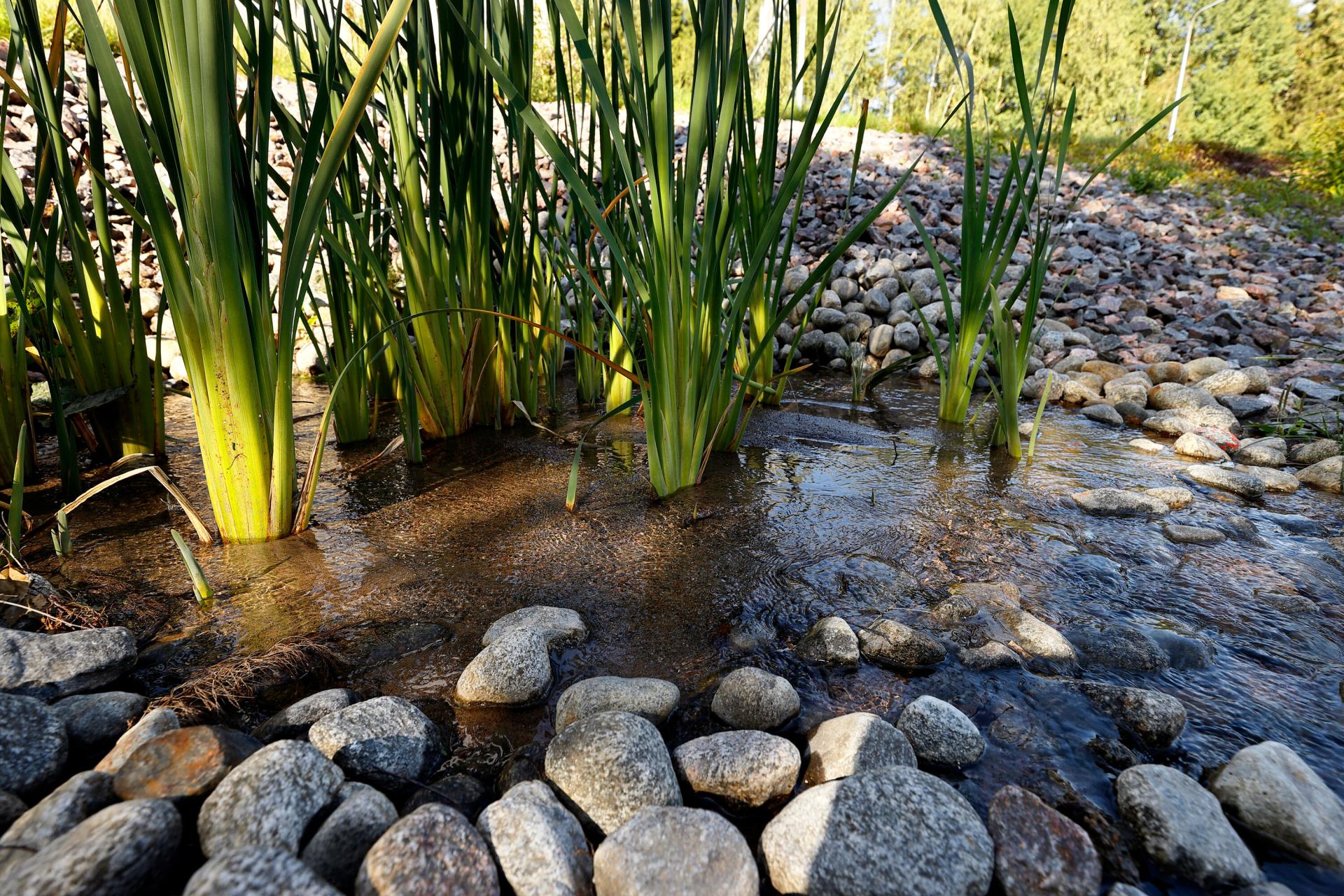
Hindering factors for nature-based stormwater management
While previous sections have addressed many of the barriers or factors hindering adoption of NBS to stormwater management, other aspects came up, too. Those were general awareness and attitude of the community.
In Vantaa, no objection was known for nature-based or natural solutions to stormwater management. In Kauniainen, community feedback that they have received is along the lines “why is the city maintaining a mosquito pond”. It was expressed that certain groups of people recognise the benefits and values of nature-based solutions, and that single staff members’, or politicians’, training, and awareness in general may facilitate nature-based solutions.
In Espoo, however, inhabitants have had concerns for instance about the stormwater detention pools, e.g. on child safety, mosquitoes or whether the standing water can start to smell. Such issues were considered to be able to be solved already in the design phase if the aim of the stormwater management structures is carefully considered, e.g. how solid matter and nutrients are removed, and how it is ensured that this structure will develop into a functioning ecosystem. As an example of community opposition, a planned stormwater pool was not built in Ruomelankorpi green area, Olari, due to inhabitants next to the area considering the change of landscape being too drastic. Therefore, instead of building the pool, the city modified an old pool upstream and built a new flood pipe, and as a result, these detain stormwater adequately.
As was showcased in Helsinki’s Maunulanpuisto park and Vantaa’s Meiramitie road, informing inhabitants of the stormwater management structures is important and can increase the acceptance of such systems.
As mentioned in Section 3.3, participation and the inclusion of stakeholders’ viewpoints from an early stage of the design of nature-based solutions are considered critical in ensuring public acceptance (EEA 2021).

